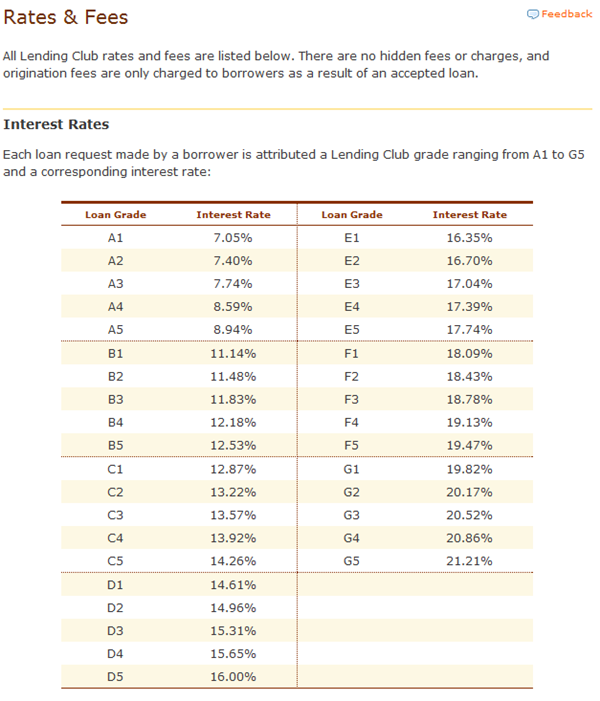Lending Club Interview and Review
I had the pleasure yesterday of interviewing Rob Garcia of Lending Club. Lending Club is a person to person financial service where borrowers can apply for loans and investors can fund those loans directly. Below is our radio interview and I will follow that up with a review of the site.
What is Lendingclub.com? – Lending Club is peer to peer marketplace for individual borrowers and investors (or lenders). It was formed in 2006 and after getting SEC approval in 2008, has seen its business grown leaps and bounds. Lending Club issued more than $6M in loans in October, which makes them the largest P2P lending operation in the world, while it keeps growing at an impressive 15% monthly.
How does it work for borrowers – For those who need to borrow, all you need to do is to sign up with some basic information. After the sign up process, you will be sent another set of questions to answer which contains more details like your salary, your job etc. Not everybody could be a borrower as there are criteria to meet. The two most important are your FICO score (which has to be at least 660) and your debt interest to income ratio (excluding mortgage) cannot exceed 25%. You can request a loan for up to $25,000 for a 3 year maturity. The interest is fixed and the loan is unsecured.
Based on the information that you give, Lending Club will run through a proprietary credit score system and assign the borrower a rating and an interest rate. Below is a screen shot showing what the ratings are and what rates are being applied.

How does it work for lenders and investors? – Once again, all you have to do is to sign up. The minimum investment is $25. All you have to do first is to deposit some more from your bank account to Lending Club. (Note that you do not earn any interest for any money sitting with them that is not invested).
You can browse the list of borrowers and even ask them questions about the reason for their loans, their past records etc. It is like being a credit officer.
Lending Club advocates diversification (who doesn’t) and claims that the the average net annualized return (after fees and defaults) is over 9.5%.
What happens when someone defaults? – According to Lending Club, the annualized default rate is slightly over 3%. Lending Club has a collection process if a borrower defaults. According to them, about 80-90% of missed payments are due to changes in bank account or temporary cash flow issues, and these loans become current again within the first 30 days of the missed payment. Late payment fees are charged to late payers and most of the fees goes into the investors pocket. Lending Club will also utilize external collection agencies if the note is deep on default.
Lenders and investors also have a choice of selling their loans in the secondary market. This requires a sign up with FOLIOfn (which is a member of Finra and SPI).
Lending Club is governed by the SEC – Lending Club is governed by the SEC. That that every loan is issued in the form of “notes” and is filed with the SEC.
Tools for Lenders – Lending Club has a statistics page which contains a lot of statistics for lenders. They contain some really cool date like
Below are screen shots of the stats page.



Why is Lending Club able to offer borrowers a lower rate and are they underpricing risk? – I asked Rob in the radio interview why was lending club able to provide a lower cost of borrowing to borrowers and if they were underpricing risk for their lenders. His answer was that Lending Club is not a bank and they do not take deposits or borrower money. Hence, they have no “funding cost hurdle” to overcome. They also do not have costs associated with having branches and a bricks and mortar bank have. Hence, they are able to pass these savings on to their borrowers and investors.
Who is Lending Club For? – On their statistics page, Lending Club has a breakdown of the use of the loans taken out by borrowers. By far and large, most borrowers make use of Lending Club as credit card consolidation loans. Some use them for small business, home improvement. This does not surprise me as credit card issuers have been clamping down on their 0% balance transfer offers. Hence, if you are looking to consolidate your debt, whether is it just credit card or other types of debt, Lending Club is a great alternative if you cannot get approved for these 0% offers. There are several advantages that Lending Club provide.
Overall, I think Lending Club is a great concept and marketplace and has been used successfully by both borrowers and lenders. I know of folks who have been denied a 0% interest credit card but managed to consolidate their credit card debt through Lending Club. It also gives lenders a chance to earn higher returns that they would if they kept their money in the bank. They key is to have a diversified portfolio of loans. I think Lending Club would continue to grow and become more mainstream. Whether you need money or are looking for a place to earn higher interest, Lending Club is the place to be. (note: I do not have an account yet with Lending Club because it is not yet available in my state. But I will open an account when it becomes available. I was told by Rob that I can still open an account but can only “secondary loans”)
Lastly, if you sign up through the link here on this page, your account will be credited with $25 bonus.
(note: Lending Club is not available in every state though they are working hard to make them available).
